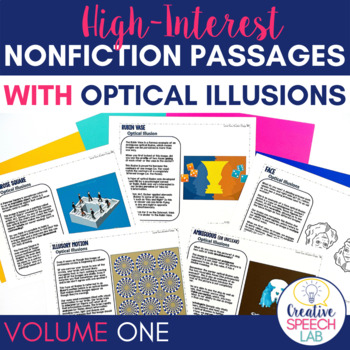High Interest Nonfiction Passages with Optical Illusions
- PDF
- Easel Activity
What educators are saying
Also included in
- Are you looking for more interesting nonfiction texts to keep your students engaged? Save 20% on this bestselling bundle of no prep, leveled nonfiction passages that make comprehension and vocabulary instruction exciting in any setting!These four highly engaging resources are differentiated and havePrice $31.50Original Price $36.00Save $4.50
Description
Are you looking for more interesting nonfiction texts to keep your students engaged? These no prep, leveled nonfiction passages make comprehension and vocabulary instruction exciting through the use of optical illusions!
This highly engaging resource is differentiated and has been written at two different levels to accommodate a wide-age range. With impressive visuals, separate student and teacher copies and data collection forms, this resource is truly print and go!
This top-rated packet includes:
★ 9 original, exciting passages about optical illusions with questions written at two complexity levels for lower grades (3-5) and older grades (6-8).
★ 8 images of real optical illusions
★ Separate student and teacher copies
★ Data collection section on the teacher copy
★ Comprehension questions and activities sorted into these 12 skill areas:
- Main Idea
- Reading/Auditory Comprehension
- WH Questions
- Vocabulary
- Context Clues
- Synonyms
- Inferencing
- Oral Language
- Comparing & Contrasting
- Attributes
- Recalling Details
- Conversational Skills
★ Comparing and Contrasting Activities with Venn Diagrams
★ BONUS Optical Illusions Card Game focusing on a wide range of skills
The Nonfiction Texts included in this packet focus on highly interesting topics including:
★ Introduction to Optical Illusions
★ Illusory Motion (i.e. circles that appear to spin)
★ Face Optical Illusions
★ Penrose Square
★ About M.C. Escher
★ Paradox (or Impossible) Optical Illusions
★ Ambiguous Optical Illusions
★ Rubin Vase
★ Kanizsa Triangle
This packet maintains printing quality when printed in black and white or gray-scale to save ink. It can also be used on the iPad with the Notability app. Instructions for using this packet with the Notability app can be found here!
This resource can be used in small group instruction or as a whole class lesson. Not only will these no prep, leveled nonfiction texts make language skill groups more interesting and motivating, they also incorporate valuable elements of STEM content!
Be sure to check out the preview file for a closer look!
You might also like these High Interest Nonfiction Passages with a Debate Theme!
• • • • • • • • • • • • • • • • • • • • • • • • • • • • • • • • • • • • • • •
Make sure to follow Claudia on Facebook and Instagram (as well as subscribe to her newsletter to receive tips and freebies!







